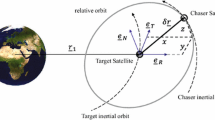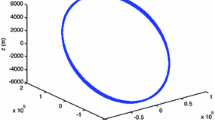Abstract
Large ΔV amounts are often required to maintain the relative geometry which is needed to implement a formation flying concept. A wise use of the orbital environment makes the orbit keeping phase easier, reducing the overall propellant consumption. A first important step in this direction is the selection of formation configurations and orbits which, while still satisfying the mission requirements, are less subject to perturbations resulting naturally in closed relative motion. Within this frame, a number of studies have been recently carried out in order to identify possible sets of invariant relative orbits under the effects of the Earth oblateness, a conservative force commonly referred to as J2 which is also the most important perturbation for Low Earth Orbit. These efforts clearly marked the difficulties connected with achieving genuine periodic relative motion under J2 effect, but they also showed the existence of a set of conditions on the orbital parameters which allow for quasi-periodic J2 trajectories. This paper presents these particular trajectories, by means of deeper theoretical explanations, showing the dependency of the shape of the relative configurations on the orbital inclination. Since the quasi-periodic trajectories cannot be written analytically, and moreover, they are very sensitive with respect to the initial conditions, difficulties arise when trying to exploit these paths as reference for the control of a formation. This paper proposes a novel approach to find, from the actual quasi periodic natural trajectories, minimal control periodic reference trajectories. Next, it evaluates quantitatively the amount of propellant which is needed to control a spacecraft formation along these paths. The choice of Hill’s classical circular projected configuration as a nominal trajectory is considered as a comparison, showing the clear advantages of the proposed guidance design, which assumes low-perturbed periodic reference orbits as nominal trajectories.
Similar content being viewed by others
References
Becerra, V.M., Biggs, J.D., Nasuto, S.J., Ruiz, V.F., Holderbaum, W., and Izzo, D.: Using Newton’s method to search for quasi-periodic relative satellite motion based on nonlinear hamiltonian models. In: 7th International Conference On Dynamics and Control of Systems and Structures in Space (DCSSS). The Old Royal Naval College, Greenwich, London (2006)
Capò-Lugo P.A., Bainum P.M.: LQR control schems to satisfy the separation distance constraints for the NASA benchmark tetrahedron constellations. Adv. Astronaut. Sci. 124, 911–930 (2006)
Charbonneau P.: Genetic algorithms in astronomy and astrophysics. Astrophys J Suppl 101, 309–334 (1995)
Fasano, G., and D’Errico, M.: Design of satellite formations for interferometric and bistatic SAR. IEEE Aerospace Conference. Big Sky, MT (2007)
Halsall M., Palmer P.L.: Modelling natural formations of LEO satellites. Celest. Mech. Dyn. Astron. 99(2), 105–127 (2007)
Izzo, D. and Sabatini, M.: Magic (special) inclinations for formation flying. In: Proceedings of the 3rd International Symposium on Formation Flying, Missions and Technologies. ESA SP-654, June 2008, ESA/ESTEC Noordwijk, The Netherlands (2008)
Izzo, D., Sabatini, M., and Valente, C.: A new linear model describing formation flying dynamics under J2 effect. In: Proceeding of the XVII AIDAA congress. Rome (2003)
Palmerini G.B., Sabatini M., Pavarin D., Manente M.: Controlled orbital dynamics of low altitude formations by means of electrical propulsion. Adv. Astronaut. Sci. 129, 2461–2476 (2007)
Ross IM.: Linearized dynamic equations for spacecraft subject to J2 perturbations. J. Guidance Control Dyn. 26(4), 657–659 (2003)
Sabatini, M., and Palmerini, G.B.: Linearized formation-flying dynamics in a perturbed orbital environment. IEEE Aerospace Conference. Big Sky, MT (2008)
Sabatini M., Izzo D., Palmerini G.B.: Analysis and control of convenient orbital configuration for formation flying missions. Adv. Astronaut. Sci. 124, 313–330 (2006)
Sabatini, M., Reali, F., and Palmerini, G.B.: Autonomous State Estimation in Formation Flight. IEEE Aerospace Conference. Big Sky, MT (2007)
Sabatini, M., Izzo, D., Bevilacqua, R.: Special inclinations allowing minimal drift orbits for formation flying satellites. J. Guidance Control Dyn. 31(1) January–February (2008)
Schweighart S., Sedwick R.: High-fidelity linearized J2 model for satellite formation flight. J. Guidance Control Dyn. 25(6), 1073–1108 (2002)
Sengupta P., Vadali S.R., Alfriend K.T.: Second-order state transition for relative motion near perturbed, elliptic orbits. Celest. Mech. Dyn. Astron. 97(2), 101–129 (2007)
Vadali S.R., Vaddi S.S., Alfriend K.T.: An intelligent control concept for formation flying satellites. Int. J. Robust. Nonlinear Control 12, 97–115 (2002)
Vadali S.R., Sengupta P., Yan H., Alfriend K.T: On the fundamental frequencies of relative motion and the control of satellite formations. Adv. Astronaut. Sci. 129, 2747–2766 (2008)
Vaddi S.S., Vadali S.R.: Linear and nonlinear control laws for formation flying. Adv. Astronaut. Sci. 114, 171–188 (2003)
Wiesel W.E.: Relative satellite motion about an oblate planet. J. Guidance Control Dyn. 25(4), 776–785 (2001)
Author information
Authors and Affiliations
Corresponding author
Rights and permissions
About this article
Cite this article
Sabatini, M., Izzo, D. & Palmerini, G.B. Minimum control for spacecraft formations in a J2 perturbed environment. Celest Mech Dyn Astr 105, 141–157 (2009). https://doi.org/10.1007/s10569-009-9214-5
Received:
Revised:
Accepted:
Published:
Issue Date:
DOI: https://doi.org/10.1007/s10569-009-9214-5




